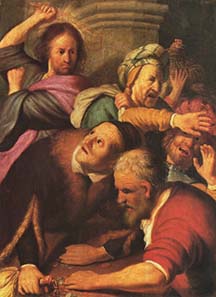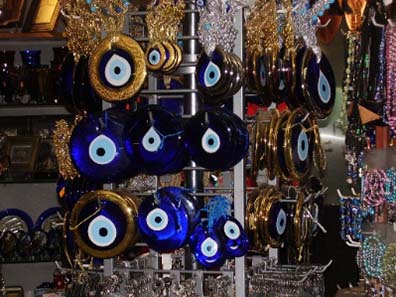by David Hendin
Around the time of Jesus, during the days of the Second Temple, according to Acts 2:5, “there were Jews living in Jerusalem, devout men, from every nation under heaven.”
In other words, in those days, vast numbers of Jews from all over the ancient world traveled to the Holy Land. In addition to their particular traditions and languages they brought their own property – including large amounts of money in the currency of their native land, or coins that they picked up in trade along their way.
Similar situations existed in other well-traveled areas of the ancient Near East where dozens of types of money, weight standards, and currency systems came together. For this reason a network of independent money changers evolved. They provided a critical service, especially in Jerusalem, where visiting Jews needed to change their local money into silver coins from Tyre in order to pay their statutory annual half-shekel dues to the Jerusalem Temple.
Christ driving the money changers from the Temple (1626), painting by Rembrandt van Rijn, Pushkin Museum / Moscow. Source: Wikipedia.
At one point the money changers were so ubiquitous, and apparently rowdy in conducting their business, that they brought some unwanted attention onto themselves: “And Jesus entered the Temple and cast out all those who were buying and selling in the Temple, and overturned the tables of the money changers …” (Matt. 21:12).
The Hebrew word for these money changers, or exchange bankers is shulhani. They were not only needed to change foreign money into the shekels and half shekels of Tyre for use in the Temple, but foreign travelers did not carry large amounts of small change. Instead they carried money in the largest denominations possible, and therefore the money changers also served the important function of breaking these down into the small denominations needed for everyday buying and selling.
Money changing in the ancient world was a business, just as it is today in airports and cities worldwide – travelers often see the signs in airports and cities worldwide: EXCHANGE – CAMBIO. Today, when you change your money from U.S. dollars to British Pounds or Euros, you pay a fee. This was exactly the same situation 2,000 years ago. Money changers charged a small fee (“agio”), which in the Rabbinic literature is called a kolbon which possibly was derived from a similar Greek word meaning “a small coin.”
There are actually three different terms used for money changers in the New Testament. The word kolbon is apparently related to the usage in Matthew 21:12, where the word used is kollybistes from the Greek root kollybos referring to the function of changing foreign currency.
In John 2:14 (“And he found in the Temple those who were selling oxen and sheep and doves, and the money-changers seated,”) the word used is kermatistes from the Greek word kermatizo meaning “to cut small” or, literally, to give small change. (This also sheds light on the actual use in ancient Palestine of coins that were literally hacked in half or into quarters and used as small change.)
In Matthew 25:27 (“Then you ought to have put my money in the bank, and on my arrival I would have received my money back with interest.”), the word used is trapezites from the word trapeza or “table.” As its context makes clear, this word refers to a different function of the money-lender, as a banker who would receive money on deposit for investment or safe-keeping, and pay out interest at a fixed rate. Even though this was specifically forbidden by Jewish law (Deuteronomy 23:20-21), there were various interpretations, and, as Daniel Sperber notes in the Encyclopedia Judaica, “The activity of the Jewish banker, shulhani, was of a closely defined nature, as his transactions had to be in accordance with the biblical prohibition against taking interest. The Talmud records much information relating to his activities. An additional and interesting feature of his business was the payment on request of sums deposited with him for that purpose.”
Thus we see the three major functions of the money changers in ancient Palestine: (a.) foreign exchange, (b.) breaking large denominations into smaller ones, and (c.) banking.
While all of these functions are of interest to students of economics and numismatists, there is a special attention paid to the fees charged to change “foreign” money into the Tyre shekels and half shekels acceptable for payment of dues to the Jerusalem Temple.
Shekel plus surcharge: If a Jew in the early first century paid his annual Temple dues with a Tyre shekel, he actually paid one shekel plus a surcharge of two kalbonot, equaling 11 prutot. His change would be one half shekel. Shown here is one shekel of Tyre plus 11 prutot of the Roman procurators of ancient Israel. Photo: David Hendin.
The Talmud interprets these in specific and interesting ways. We discussed this issue with a serious numismatist who is also a Talmudic scholar, Rabbi Benjamin Yablok. He observed that the Talmud specifies that if a man went to the Jerusalem Temple and wanted to pay his half-shekel, but only had a full shekel and needed change, a particular situation existed. The man had to give to the Temple not only the silver Tyre shekel, but an additional fee of “two kalbons” (in Hebrew the plural of kalbon is kalbonot). He would then be credited with full payment and would receive half a shekel as his change. The reason for this, Rabbi Yablok explains, is that it was vital for the Temple to get “full value,” and that an individual should not be able to make a savings by skipping the money changer, but instead that benefit should still go to the Holy Temple. The money changer’s fee to make change for one shekel was one kalbon. Thus the Temple’s financial experts looked at the transaction described at the beginning of this paragraph as a double one, hence requiring two kalbons as a fee.
The Talmud goes a step further. If two men went to the Temple together and wanted to pay their half shekels together with a single shekel coin, they still had to pay the kalbon fee.
The amount of the fee was one-half maah. The exact amount of one maah was a subject of considerable discussion in the Talmud. The generally accepted consensus of the Rabbis says that one maah equaled one forty-eighth of a selah (selah was another word used for shekel at this time). However, Rabbi Meir issued a minority opinion stating his believe that a maah should equal one twenty-fourth of a selah.
The maah, then, equaled either about 2.1 or 4.2 percent of a shekel, and this is equal to either 5.5 or 11 prutot, based on the exchange standard during the Roman period (around 6 to 70 A.D.), when the shekel was worth 256 toprut, and the half shekel 128 prutot. Once again, the Rabbis deemed it critical that under any circumstances that the temple should get “full value” and there must be no way to circumvent it. As explained by Herbert Danby’s footnote to the Oxford University translation of the Mishnah, the surcharge was “compensation to the Temple’s Shekel-collectors to reimburse them for any loss incurred in changing the shekels or half shekels into or out of other money.”
Discussing Danby’s footnote, Rabbi Yablok says that it does not appear from the Hebrew commentators that the Temple people were worried about an exchange loss. “Rather,” he says, “they followed the general rule that in any transaction, the Temple should come out ahead, regardless of what the payer was doing. This was a step in preserving the dignity and respect of the Temple. Imagine today a person trying to deal with a synagogue (or a church) in a way that saved themselves money with the synagogue not benefiting, when the general consensus is that a communal institution should benefit.”
As further example of this, Rabbi Yablok also observes that Rabbi Meir had another minority opinion, who said that even if a man went to the Temple with a silver half shekel of Tyre in his hand, because the half shekel was made by humans, and therefore something less than perfect, the person still had to pay a bonus of one kalbon in order for the Temple to get full value.
Today nazar (“Blue eyes”) are a commonly used protection against the evil eye in the Middle East.
There is a related story, which I have told in my book Guide to Biblical Coins. In a 1964 excavation at the ancient settlement of Ein-Gedi on the shore of the Dead Sea, a house from the first century AD was being explored.
In a plaster wall they discovered an ancient oil lamp that contained 139 prutot, mainly from the Roman prefects and procurators who ruled Judaea under Rome between 6 and 66 AD. It was concluded that 139 coins could not constitute a hoard in the usual sense, because their value was so small. While showing me this oil lamp and group of coins in The Israel Museum many years ago, Ya’akov Meshorer reconstructed the story for me as follows:
“A Jew in the year 60 C.E. built his house, and, while finishing it, before its last plaster stage, decided to hide a sacred amount of money in the wall to protect against the evil eye.”
The most sacred sum of money to the Jews at this time was the half-shekel, since this was the amount each man paid to the Temple annually. But, according to Meshorer, our first-century Jew did not want simply to put a single, silver half shekel into his wall for luck since “the large number of coins would make a better impression.” The man also decided to put the money into a lamp – “a symbol of eternity.”
But wait. Half a shekel was equal to only 128 of the prutot. So why did the archaeologists find 139?
An exchange fee of two kalbons (kalbonot) on half a shekel equals just about 11. Adding 128 plus 11 … exactly 139 prutot. The owner of the house wanted to make sure that when it came to his good luck, every precaution was taken to insure accuracy!
by courtesy of David Hendin, Copyright 2002 by David Hendin, all rights reserved.
If you want to know more about David Hendin, specialist for Jewish coin, please visit his website and click here.






